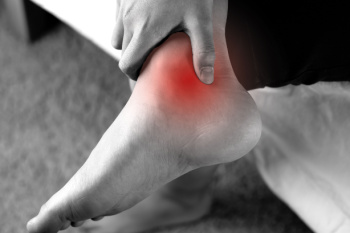March 2024
Excess Weight and Circulatory Issues of the Feet

Poor circulation in the feet refers to reduced blood flow to the lower extremities, leading to symptoms like cold feet, numbness, tingling, and slow wound healing. It occurs when blood vessels become narrowed or blocked, restricting the flow of oxygen-rich blood to the feet. Typical causes of poor circulation include peripheral artery disease, atherosclerosis, diabetes, smoking, high blood pressure, and high cholesterol levels. Obesity can exacerbate poor circulation in the feet due to several factors. Excess body weight increases the workload on the heart and blood vessels, leading to conditions like hypertension and atherosclerosis. Fat accumulation around blood vessels can also compress them, further impairing blood flow. Managing poor circulation involves lifestyle changes like regular exercise, maintaining a healthy weight, quitting smoking, and controlling underlying medical conditions. In severe cases, medical interventions like medications or surgical procedures may be necessary to improve blood flow. If you have symptoms of poor circulation in your feet, it is suggested that you schedule an appointment with a podiatrist for a proper diagnosis and treatment.
The more you weigh, the harder your feet must work to support your body. If you’re an obese individual and are concerned about your feet, contact John Horlebein, DPM from Northern Cascades Foot & Ankle, LLC. Our doctor can provide the care you need to keep you pain-free and on your feet.
Obesity and Your Feet
People who are overweight are putting more pressure on their ankles, knees, and hips as well as their feet. This unfortunately can lead to variety of different issues.
Problems & Complications Stemming from Obesity
- When the body is overweight, it tries to compensate by changing the way that it moves. An obese person may lean forward and put extra weight on the wrong part of the foot. This puts unnecessary stress on the feet.
- Obese people are also more likely to develop type II diabetes which is a condition that causes a lot of foot problems. People with diabetes often don’t feel the cuts and sores that they may have on their feet, which can lead to more complicated and severe issues.
- Plantar fasciitis is another foot condition that can be caused by obesity. Plantar fasciitis is an inflammation of the tissue along the bottom of the foot, which causes pain and stiffness while walking and climbing stairs.
If you have any questions, please feel free to contact our office located in Chelan, WA . We offer the newest diagnostic and treatment technologies for all your foot care needs.
What Is Tarsal Tunnel Syndrome?
 Tarsal tunnel syndrome is a compressive neuropathy condition that results from the entrapment of the posterior tibial nerve as it passes through the tarsal tunnel, a narrow passageway located on the inner side of the ankle. This entrapment leads to many symptoms, most notably pain, tingling, and burning in the foot and heel, which sometimes extends into the toes and lower leg. Many things can cause tarsal tunnel syndrome, such as injuries to the ankle, swelling from other health problems like diabetes, or just by repeating the same movements that irritate the area. Treatment strategies are tailored to the severity and underlying cause of the syndrome. Conservative measures include anti-inflammatory medications and orthotic devices to alleviate pressure on the nerve. More invasive options include surgical decompression to relieve the nerve entrapment. Tarsal tunnel syndrome can be hard to diagnose because its symptoms overlap with other nerve-related conditions. Podiatrists, or foot doctors, can do comprehensive evaluations to properly diagnose tarsal tunnel syndrome. If you have foot pain, or suspect tarsal tunnel syndrome, it is suggested that you seek treatment from a podiatrist who can properly diagnose this condition and offer a personalized treatment plan.
Tarsal tunnel syndrome is a compressive neuropathy condition that results from the entrapment of the posterior tibial nerve as it passes through the tarsal tunnel, a narrow passageway located on the inner side of the ankle. This entrapment leads to many symptoms, most notably pain, tingling, and burning in the foot and heel, which sometimes extends into the toes and lower leg. Many things can cause tarsal tunnel syndrome, such as injuries to the ankle, swelling from other health problems like diabetes, or just by repeating the same movements that irritate the area. Treatment strategies are tailored to the severity and underlying cause of the syndrome. Conservative measures include anti-inflammatory medications and orthotic devices to alleviate pressure on the nerve. More invasive options include surgical decompression to relieve the nerve entrapment. Tarsal tunnel syndrome can be hard to diagnose because its symptoms overlap with other nerve-related conditions. Podiatrists, or foot doctors, can do comprehensive evaluations to properly diagnose tarsal tunnel syndrome. If you have foot pain, or suspect tarsal tunnel syndrome, it is suggested that you seek treatment from a podiatrist who can properly diagnose this condition and offer a personalized treatment plan.
Tarsal tunnel syndrome can be very uncomfortable to live with. If you are experiencing tarsal tunnel syndrome, contact John Horlebein, DPM of Northern Cascades Foot & Ankle, LLC. Our doctor can provide the care you need to keep you pain-free and on your feet.
Tarsal Tunnel Syndrome
Tarsal tunnel syndrome, which can also be called tibial nerve dysfunction, is an uncommon condition of misfiring peripheral nerves in the foot. The tibial nerve is the peripheral nerve in the leg responsible for sensation and movement of the foot and calf muscles. In tarsal tunnel syndrome, the tibial nerve is damaged, causing problems with movement and feeling in the foot of the affected leg.
Common Cause of Tarsal Tunnel Syndrome
- Involves pressure or an injury, direct pressure on the tibial nerve for an extended period of time, sometimes caused by other body structures close by or near the knee.
- Diseases that damage nerves, including diabetes, may cause tarsal tunnel syndrome.
- At times, tarsal tunnel syndrome can appear without an obvious cause in some cases.
The Effects of Tarsal Tunnel Syndrome
- Different sensations, an afflicted person may experience pain, tingling, burning or other unusual sensations in the foot of the affected leg.
- The foot muscles, toes and ankle become weaker, and curling your toes or flexing your foot can become difficult.
- If condition worsens, infections and ulcers may develop on the foot that is experiencing the syndrome.
A physical exam of the leg can help identify the presence of tarsal tunnel syndrome. Medical tests, such as a nerve biopsy, are also used to diagnose the condition. Patients may receive physical therapy and prescriptive medication. In extreme cases, some may require surgery.
If you have any questions please feel free to contact our office located in Chelan, WA . We offer the newest diagnostic and treatment technologies for all your foot and ankle needs.
Treatment of Chronic Diabetic Foot Wounds

Healing wounds properly involves cells moving and tissue rebuilding in a coordinated way. But in some wounds, like those in diabetes, this process does not work well due to various issues like poor blood flow, infections, and ongoing damage. There's hope for treating such wounds better. By understanding and fixing these issues, following proper care, and using new medical technology, there can be improvement for people with stubborn wounds. If you are diabetic and have chronic foot wounds, it is suggested that you make an appointment with a podiatrist to discuss any new medical technology that might be applied to your case and provide you with relief.
Wound care is an important part in dealing with diabetes. If you have diabetes and a foot wound or would like more information about wound care for diabetics, consult with John Horlebein, DPM from Northern Cascades Foot & Ankle, LLC. Our doctor will assess your condition and provide you with quality foot and ankle treatment.
What Is Wound Care?
Wound care is the practice of taking proper care of a wound. This can range from the smallest to the largest of wounds. While everyone can benefit from proper wound care, it is much more important for diabetics. Diabetics often suffer from poor blood circulation which causes wounds to heal much slower than they would in a non-diabetic.
What Is the Importance of Wound Care?
While it may not seem apparent with small ulcers on the foot, for diabetics, any size ulcer can become infected. Diabetics often also suffer from neuropathy, or nerve loss. This means they might not even feel when they have an ulcer on their foot. If the wound becomes severely infected, amputation may be necessary. Therefore, it is of the upmost importance to properly care for any and all foot wounds.
How to Care for Wounds
The best way to care for foot wounds is to prevent them. For diabetics, this means daily inspections of the feet for any signs of abnormalities or ulcers. It is also recommended to see a podiatrist several times a year for a foot inspection. If you do have an ulcer, run the wound under water to clear dirt from the wound; then apply antibiotic ointment to the wound and cover with a bandage. Bandages should be changed daily and keeping pressure off the wound is smart. It is advised to see a podiatrist, who can keep an eye on it.
If you have any questions, please feel free to contact our office located in Chelan, WA . We offer the newest diagnostic and treatment technologies for all your foot care needs.
A Surgical Solution for Bunions

Bunion surgery, medically known as hallux valgus correction, is a procedure aimed at addressing this often painful deformity of the big toe joint. Typically caused by the misalignment of bones, bunions can lead to discomfort, difficulty in shoe-wearing, and decreased quality of life. The surgical process involves making an incision near the affected joint, allowing the surgeon to access and realign the bones and ligaments. In some cases, small screws or plates may be used to secure the corrected alignment. Post-surgery, patients undergo a recovery period during which they are advised to keep weight off the foot and follow a rehabilitation plan. While bunion surgery offers relief from the physical challenges posed by bunions, it is suggested that individuals considering the procedure consult with a podiatrist to determine the most suitable course of action based on their specific condition and overall health.
Foot surgery is sometimes necessary to treat a foot ailment. To learn more, contact John Horlebein, DPM of Northern Cascades Foot & Ankle, LLC. Our doctor will assist you with all of your foot and ankle needs.
When Is Surgery Necessary?
Foot and ankle surgery is generally reserved for cases in which less invasive, conservative procedures have failed to alleviate the problem. Some of the cases in which surgery may be necessary include:
- Removing foot deformities like bunions and bone spurs
- Severe arthritis that has caused bone issues
- Cosmetic reconstruction
What Types of Surgery Are There?
The type of surgery you receive will depend on the nature of the problem you have. Some of the possible surgeries include:
- Bunionectomy for painful bunions
- Surgical fusion for realignment of bones
- Neuropathy decompression surgery to treat nerve damage
Benefits of Surgery
Although surgery is usually a last resort, it can provide more complete pain relief compared to non-surgical methods and may allow you to finally resume full activity.
Surgical techniques have also become increasingly sophisticated. Techniques like endoscopic surgery allow for smaller incisions and faster recovery times.
If you have any questions please feel free to contact our office located in Chelan, WA . We offer the newest diagnostic and treatment technologies for all your foot and ankle needs.







